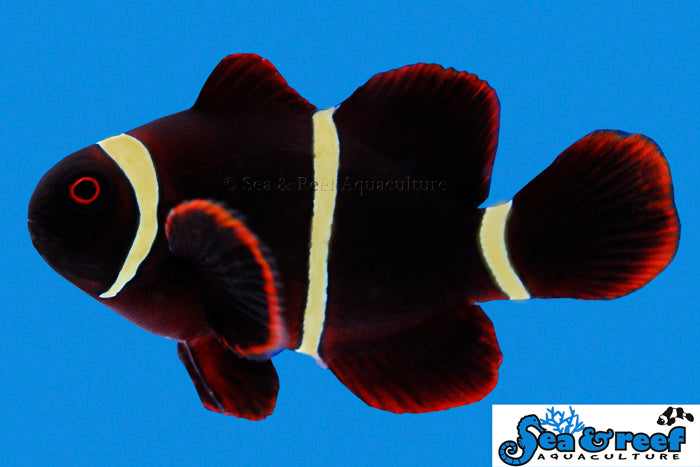Your Cart
From the Breeder
Name:
Gold Stripe Maroon
Maximum Size:
6” (15 cm)
The Gold Stripe Maroon Clownfish is the largest species of clownfish and can reach a size of 6 inches. It has maroon body coloration with three wide yellow body stripes. There is another strain of Maroon Clownfish called White Stripe Maroon Clownfish. This variation looks similar to the Gold Stripe Maroon Clownfish, except it has three narrow white stripes. Maroon Clownfish belong to the genus Premnas and is therefore different than all the other clownfish species, which belongs to the genus Amphiprion. Premnas is latin for “spiny cheek” and if you look closely you will see the spines protruding from each side of the head underneath the eyes. When Gold Stripe Maroon Clownfish are early juveniles, their stripes are white. The yellow color will develop when they are about 12 months old. In adult fish the larger female will often turn a darker red color, while the smaller male retains it orange coloration. Females are much larger than males – typically 3-4 times larger. Maroon Clownfish become very territorial as adults and it is best to not mix them with any other clown species.
Maroon Clownfish have a wide distribution in the Western Pacific Ocean and the Indian Ocean. It can be found west to Sumatra, east to Vanuatu, north to the Philippine Sea and south to New Caledonia.
Temperament & Captive Care
The Maroon Clownfish is the largest known species of clownfish and has developed a reputation for their bold behavior. The females can grow to 6” and can be very territorial especially when defending a nest of eggs. It is best to not mix maroon clownfish with any other clownfish species in your tank and to only keep a mated pair or a single fish. Captive bred Maroon Clownfish are generally less aggressive compared to wild collected fish.
Maroon Clownfish have a healthy appetite. Most clownfish are omnivorous feeders, meaning that they will consume a variety of different food types. In nature the diet of clownfish consists of crustaceans (such as copepods and amphipods), algae, polychaete worms and leftovers from the anemone’s meal. Our captive bred fish are conditioned to eat a variety of aquarium diets including pellets, flake food, frozen Mysis shrimp, and frozen brine shrimp.
Natural Host Anemones
In the wild Maroon Clownfish are very selective and almost always found hosting in the Bubble Tip anemone (Entacmaea quadricolor).
Aquarium Host Anemones
Clownfish do not require host anemones to survive or thrive. However, in most cases they will readily accept them. For Maroon Clownfish we recommend the popular and hardy Bubble Tip Anemone (Entacmaea quadricolor).
Popular Fish
-
Orchid Dottybacks
$39.99$44.99 -
Neon Dottybacks
$39.99$44.99 -
Longfin Phantom Clownfish
$274.99







